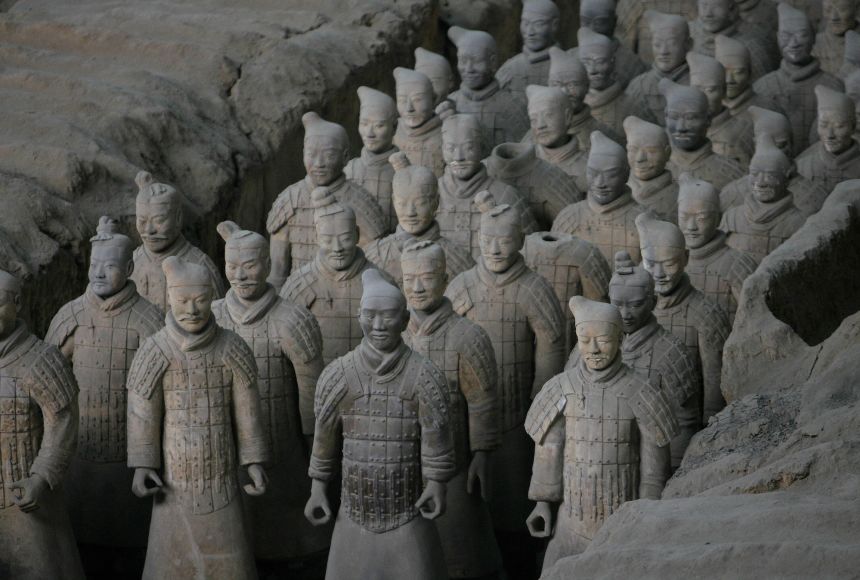The Chinese empire was one of the most enduring empires on Earth. Throughout its long history, various dynasties—family groups that ruled the empire—rose and fell. The period during which a particular family ruled is also called a dynasty.
Single dynastic families often remained in power for hundreds of years, until being replaced by another powerful family group. The throne was passed from father to son.
Myth or Reality?
The Xia dynasty is traditionally said to be the first of many ancient Chinese ruling houses. It is thought to have existed from around 2070 until 1600 B.C.E. Yet the existence of this dynasty has been debated. Many researchers see it as nothing but a myth.
The first Xia king, Yu, is said to have repaired the damage caused by a major flood. For this reason, legend has it, the gods awarded him the Mandate of Heaven, or the right to rule. This right was passed down through his family line.
The Xia dynasty is said to have been overthrown in 1600 B.C.E. by the first Shang leader. Because the existence of the Xia dynasty is debated, the Shang dynasty is sometimes seen as the first of China's dynasties.
The Shang rulers maintained control for around 600 years. The period of their rule saw the invention of Chinese writing, and many later historians viewed it as China's "Golden Age." In 1046 B.C.E. the Shang king was overthrown by the first Zhou king, ending the Shang dynasty.
The Zhou dynasty was the longest of ancient China's dynasties. It lasted from 1046 to 256 B.C.E. Some of ancient China's most important writers and philosophers lived during this period, including Confucius and the first Taoist thinkers.
The years from 476 to 221 B.C.E. are known as the "Warring States Period." During this time, the seven regions controlled by the Zhou began fighting among each other. Ultimately, the Qin armies won this struggle in 256 B.C.E. and overthrew the Zhou leaders.
"China" and the Terracotta Warriors
The Qin dynasty only lasted 15 years, from 221 to 206 B.C.E., however, it was an important time in Chinese history. It was a period of unification, during which territories surrounding China were brought under Chinese rule.
The first Qin leader, Qin Shin Huang (also sometimes called Shi Huangdi or Qin Shi Huang), began work on what would become the Great Wall of China. He died in 210 B.C.E. and was buried with a huge terracotta army consisting of almost 8,000 statues. Qin Shin Huang was followed by his son, Qin Er Shi. Qin Er Shi's reign lasted for just three years before he was unseated in 206 B.C.E. The leader of the rebels, Liu Bang, became the first emperor of the Han dynasty.
The Han dynasty (206 B.C.E. to 220 C.E.) marked another Golden Age of China. During this time, Confucianism became the official state religion, and the Silk Road—a trade route from Asia to southern Europe and East Africa—was established. In 220 C.E., the last Han emperor was overthrown. Han rule was followed by a period known as the Three Kingdoms.
During the Three Kingdoms period (220-280 C.E.), China was divided into three states: Cao Wei, Shu Han, and Dong Wu. The region further broke apart into the northern and southern territories between 386 and 581 C.E.
In 581 C.E., the Sui dynasty emerged. Although it was short-lived, the Sui dynasty managed to unify the northern and southern territories. In the year 618 C.E., however, the Sui were overthrown by the Tang.
The Tang dynasty (618–906 C.E.) is often described as the greatest of the dynasties. Its members included China's only female ruler, Empress Wu Zetian (625–705 C.E.), who reigned for 20 years.
Mongol Takeover
A period of warring followed the Tang dynasty. In 960 C.E., the Song dynasty came to power and during this period, the world's first paper money was issued. The Song dynasty lasted until 1279 C.E. when it was defeated by the Mongols. The Mongols then ruled China as the Yuan dynasty from 1279 until 1368 C.E.
The Yuan dynasty was overthrown in 1368 C.E. by the Ming Emperor Zhu Yuanzhang. The Ming emperors expanded the Great Wall of China to preserve the crumbling borders. Invading Manchu forces eventually ended the Ming dynasty in 1644 C.E.
The Last Emperors
The Manchu invaders established the Qing dynasty, which ruled from 1644 to 1911 C.E. The Qing empire was relatively stable. However, the 19th and 20th centuries brought China into increasing conflict with Western powers. In 1911 C.E., the last of the Chinese emperors, Puyi, stepped down. China then became a republic.

